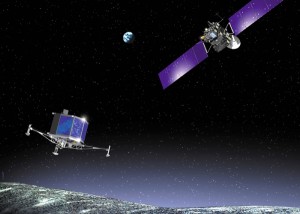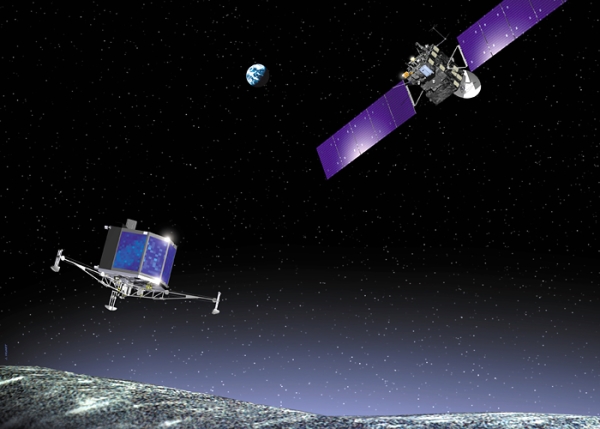 Next month, the Rosetta spacecraft is scheduled to land on a comet named 67P/Churyumov–Gerasimenko (67P/C-G). Launched by the European Space Agency (ESA) in 2004, this ambitious project aims to provide the most in depth understanding of a comet in human history. But safely landing a spacecraft the size of a compact car on a massive comet (miles across) is a daunting task.
Next month, the Rosetta spacecraft is scheduled to land on a comet named 67P/Churyumov–Gerasimenko (67P/C-G). Launched by the European Space Agency (ESA) in 2004, this ambitious project aims to provide the most in depth understanding of a comet in human history. But safely landing a spacecraft the size of a compact car on a massive comet (miles across) is a daunting task.
Selecting the right landing spot is a key element to the success of the mission. But how to pick a landing spot on a comet whose surface features are virtually unknown is something that engineers had to solve. The solution came in the form of using the Rosetta spacecraft to map the comet’s surface in detail and then use a 3D printer to create a highly accurate 3D scaled replica of the comet.

“Having a physical object in our hands, to hold, observe and show definitely helped us make our decision. Even if you have a good imagination, it’s always easier to plan the journey when you have the 3D print on hand,” explains Philippe Gaudon, Centre National d’Etudes Spatiales (CNES) Project Manager of the Rosetta mission.
Last August, after a 10 year journey through space, Rosetta became the first spacecraft to successfully rendezvous with a comet with the intent to enter orbit. With the active mapping underway, the team has been using 3D printing services from a company called Sculpteo (www.scuplteo.com) to produce the 3D scaled model of the comet.
“Even though I heard a lot about 3D printing, I had never seen a 3D print with my own eyes. I’m really satisfied with the finale version we got from Sculpteo,” Gaudon explains.
“Several years ago, when we scanned Steins and Lutetia asteroids, we ordered physical versions of it made through manual plaster molding. But it was definitely less precise than the print we got for 67P/Churymov-Gerasimenko. It was also a lot faster: we got the print exactly one week after we uploaded it on Sculpteo’s website.”
Attached to the Rosetta spacecraft is the lander, named Philae. Named after Philae Island, where an obelisk was found and used in addition to the Rosetta stone to decipher Egyptian hieroglyphics, Philae will make the descent to the surface of the comet and hopefully touch down safely at the selected landing site in November 2014.
![Herbal Reference Substances are Key to Everyday Products <!-- AddThis Sharing Buttons above -->
<div class="addthis_toolbox addthis_default_style " addthis:url='http://newstaar.com/herbal-reference-substances-are-key-to-everyday-products/3512112/' >
<a class="addthis_button_facebook_like" fb:like:layout="button_count"></a>
<a class="addthis_button_tweet"></a>
<a class="addthis_button_pinterest_pinit"></a>
<a class="addthis_counter addthis_pill_style"></a>
</div>When it comes to quality control testing and the development of new products, Botanical Reference Materials (BRMs), also known as Herbal References are critically important. To help companies ultimately obtain all-important FDA approval, the Food and Drug Administration provides in its guidance a recommendation that […]<!-- AddThis Sharing Buttons below -->
<div class="addthis_toolbox addthis_default_style addthis_32x32_style" addthis:url='http://newstaar.com/herbal-reference-substances-are-key-to-everyday-products/3512112/' >
<a class="addthis_button_preferred_1"></a>
<a class="addthis_button_preferred_2"></a>
<a class="addthis_button_preferred_3"></a>
<a class="addthis_button_preferred_4"></a>
<a class="addthis_button_compact"></a>
<a class="addthis_counter addthis_bubble_style"></a>
</div>](http://newstaar.com/wp-content/uploads/2021/02/Achillea_millefolium_flowers-100x100.jpg)
![Quality Electrochemical Biosensors are Critical for Medical, Food and Chemical Industry <!-- AddThis Sharing Buttons above -->
<div class="addthis_toolbox addthis_default_style " addthis:url='http://newstaar.com/quality-electrochemical-biosensors-are-critical-for-medical-food-and-chemical-industry/3512086/' >
<a class="addthis_button_facebook_like" fb:like:layout="button_count"></a>
<a class="addthis_button_tweet"></a>
<a class="addthis_button_pinterest_pinit"></a>
<a class="addthis_counter addthis_pill_style"></a>
</div>A number of industries have, at their core, a need to frequent or even continuous analysis of biological media. These include the medical and pharmaceutical fields, biotech firms, and food and chemical companies. To maintain quality standards and develop new products, these industries rely heavily […]<!-- AddThis Sharing Buttons below -->
<div class="addthis_toolbox addthis_default_style addthis_32x32_style" addthis:url='http://newstaar.com/quality-electrochemical-biosensors-are-critical-for-medical-food-and-chemical-industry/3512086/' >
<a class="addthis_button_preferred_1"></a>
<a class="addthis_button_preferred_2"></a>
<a class="addthis_button_preferred_3"></a>
<a class="addthis_button_preferred_4"></a>
<a class="addthis_button_compact"></a>
<a class="addthis_counter addthis_bubble_style"></a>
</div>](http://newstaar.com/wp-content/uploads/2020/10/Electrochemical-Biosensor-100x100.jpg)
![Company Develops Industrial Mixers Well-Suited for both Fragile and Explosive Products <!-- AddThis Sharing Buttons above -->
<div class="addthis_toolbox addthis_default_style " addthis:url='http://newstaar.com/company-develops-industrial-mixers-well-suited-for-both-fragile-and-explosive-products/3512071/' >
<a class="addthis_button_facebook_like" fb:like:layout="button_count"></a>
<a class="addthis_button_tweet"></a>
<a class="addthis_button_pinterest_pinit"></a>
<a class="addthis_counter addthis_pill_style"></a>
</div>Industrial drum mixers are normally applied to blend mixes of varying viscosities such as adhesive slurries or cement. Some of these mixers have the capability of blending mixes of very different particle sizes such as fruit and ice cream, and gravel and cement slurry. The […]<!-- AddThis Sharing Buttons below -->
<div class="addthis_toolbox addthis_default_style addthis_32x32_style" addthis:url='http://newstaar.com/company-develops-industrial-mixers-well-suited-for-both-fragile-and-explosive-products/3512071/' >
<a class="addthis_button_preferred_1"></a>
<a class="addthis_button_preferred_2"></a>
<a class="addthis_button_preferred_3"></a>
<a class="addthis_button_preferred_4"></a>
<a class="addthis_button_compact"></a>
<a class="addthis_counter addthis_bubble_style"></a>
</div>](http://newstaar.com/wp-content/uploads/2020/06/bandeau-sofragir2-100x100.jpg)